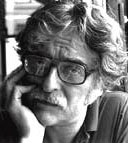 |
→ July 2004 Contents → Column
|
Nuts and Bolts
July 2004
|
 |
|
Last month I said we would talk about some of the changes a good black-and-white silver printer has to make in his technique when he moves to the dry darkroom of the computer. Silver printers tend to make a print that looks good in the mid tones. If highlights are too light, they are "burned down." And shadows that are too dark are "dodged" open. Added highlight and shadow detail can not be afterthoughts in digital printing. Whether you're scanning an existing black-and-white negative or shooting digital that may be converted from RGB to Grayscale, the shadow and highlight detail you need in the final print has to be present in the scan or digital camera file. If it's not, it just isn't there. There's no dodging or burning to bring it back. Check the histogram of the image in your digital camera. Make sure areas that aren't specular highlights are holding detail. This may mean giving up auto exposure for manual and losing some shadow detail. (When you are scanning a black-and-white negative, make sure those areas fall below Photoshop's top 255 mark on the histogram. I like 240 for light values in the final print.) To a great degree, digital photography is much like shooting color slides. Expose for the highlights and pray for the shadows (even when the final presentation will be a black-and-white print). You quickly learn to pre-visualize what a scene will look like in the final print and compensate for the fact that the print is going to have less shadow detail than the human eye could discern in the original scene. Unfortunately, with either a scan or a digital camera file, the mid tones can also often be too dark when the exposure guarantees detail in the lighter values. The answer in slide photography was a prayer that the subject would lift its head into the light or that you could use fill-in flash. It's a lot simpler with digital. When getting good detail in the lighter values gives you mid tones that are too dark, change your gamma. (In Photoshop that is the middle slider in the "levels" histogram.) If you think that image looks too flat, throw up a duplicate layer and hit "Auto Levels." For me, that almost always looks too harsh, too contrasty and with too little shadow and highlight detail. But, if the original layer looks too flat and wishy-washy to you, you can adjust the proportion of these two layers to come up with something that pleases you. When computer color printing, I have little problem setting up an image on the computer screen and producing a print that matches it. I use appropriate color spaces, a calibrated monitor and the Imageprint program. Yet, in black-and-white I still make test prints. I think this is because color is such a dominant force in color printing, that, when you get it right, other variables become relatively insignificant. Even when silver printing black-and-white, I would make prints with variations in density and contrast for different viewing conditions. Framed exhibition prints are exhibited in every conceivable lighting condition from the near dark of hallways to walls illuminated by skylights and picture windows. And that's during the daylight. Wait 'til the sun sets. I once took an incident meter around to museums and galleries. I changed from an innocent in awe of those august walls to a broken and embittered skeptic who realized that, at least in intensity - light intensity - these arbiters of taste were without standards. So, now, when a black-and-white print comes out of my Epson, I run it around the house. It gets looked at in the dark hallway, the dark hallway with the tungsten spotlights, the normal wall and the wall near the big window. Final adjustments and further inspections are made before the final print run. And then I do what no silver printer can do: I go out to lunch while the computer cranks out 10 matched prints.
© Bill Pierce
Contributing Writer
|
|
Back to July 2004 Contents |
|